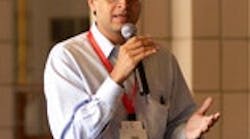Honeywell Process Solutions’ UniSim platform will now incorporate UOP simulation models to train refinery operators how to best run UOP processes used in the production of fuels and petrochemicals, announced Harsh Chitale, Honeywell vice president of strategy and global marketing, at a press conference today at the company’s annual users group meeting.
UOP, headquartered in Des Plaines, Illinois, USA, is a leading international supplier and licensor of process technology, catalysts, adsorbents, process plants and consulting services to the petroleum refining, petrochemical and gas processing industries. The company was purchased in 2005 by Honeywell.
“It will allow you to sit behind the screen and be just like you are working directly with the process.” Honeywell’s Harsh Chitale on the training benefits of UOP Master Simulation Models embedded within the company’s UniSim environment.
“It will allow you to sit behind the screen and be just like you are working directly with the process,” Chitale said.
“Many OTS developers are often forced to estimate the mathematical models for patented processes, but the UOP Master Simulation Models have the UOP intellectual property embedded in the software,” said Mark Baker, UOP senior manager of strategic alliances. “These models are as close as you can possibly get to a real-life refining operation.”
“UniSim has proven an effective tool for improving operator performance, which ultimately leads to a more efficient workforce and better business results,” said Zak Alzein, director of industry marketing for Honeywell Process Solutions. “Because it captures UOP’s extensive process knowledge within UniSim, the UOP Master Simulation Models provide an even more realistic simulation environment.”
The UniSim family of software and services includes:
- The UniSim Design suite, which offers a powerful steady-state tool that helps engineers create optimal process designs based on critical business objectives. A dynamic simulation option is also available to gain valuable insights into process behavior at every phase of a plant's life cycle.
- The UniSim Operations suite, which provides an advanced operator training solution, plus capabilities for control system checkout. Well-trained personnel react more quickly and defuse process situations before incidents occur. This is also a tool for learning a new system before commissioning or for quickly training new hires.
- The UniSim Optimization suite, which offers optimization of plant operations to ensure responsiveness to changes in business demands through close linkages with planning, scheduling and management functions.
Manufacturers from a wide range of industries use UniSim to train operators before new process units are commissioned or before new processes are implemented in existing plants. Operators also practice start-up and shutdown sequences for plant processes and learn how to sustain unit operation at peak performance levels. The results include safer and more efficient operation and less unplanned downtime.
“This is going to become even more important as we reach out for more manpower,” Alzein said. “The ability to shorten the training cycle will be critical to profitability and productivity.”




